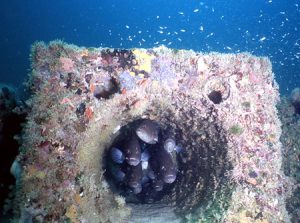New Ask IFAS publications explore the effects of Florida’s popular artificial reefs on habitats, fishing stocks, and economies
Several Ask IFAS publications explore the complex interplay between fish, anglers, divers, and the Florida environment on artificial reefs. These publications are designed to help managers decide where and when to deploy artificial reefs to maximize fishing and diving fun in Florida and benefit habitat, fish, and the human communities that depend on fishing and diving revenues.
If you build it, they will come!
It’s easy to see the potential benefits of human-built reefs. Fish flock to them because they offer both food and refuge. And anywhere fish congregate, people with nets, rods and reels, and snorkeling and scuba gear are sure to follow. Florida’s recreational anglers and divers have discovered that artificial reefs are often teeming with fish. This makes them very popular recreational enhancements and can give local communities that rely on recreation a valuable economic boost.

Here’s where it gets complicated:
Do these popular fishing and snorkling spots… A. actually help fishing stocks grow? Or do they: B. merely pull fish from other habitat and make them easier to catch—and possibly make it more likely that stocks will become depleted?
Or is it in most cases neither A. nor B. but the dreaded C.? Is it most often a complicated, case-by-case determination? Because each potential manufactured reef deployment decision must take into account many different environmental and social factors? And do these factors also wax and wane and change constantly over time after the reefs go into the environment? All of which makes the management effort quite difficult?
(Hint: Of course it’s C. It’s always C.)
Solutions
To help communities and fisheries managers trying to wrangle the complexities, UF/IFAS fisheries researchers are monitoring Florida’s manufactured reefs. Getting the balance right is key for vulnerable fishing stocks and the people who rely on them. The primary goal is to protect fish populations. All stakeholders agree that job one is to avoid a population crash that could leave anglers and divers disappointed and communities in economic distress. It’s easier and less costly to avoid a crash in the first place than to rebuild a fishery after a crash.
New and forthcoming publications in Ask IFAS describe ongoing research into the different types of synthetic reefs and their pros and cons. They also explain how managers can best deploy the various types. With continued study and fine-tuning, scientists are developing reliable strategies managers can use to ensure that the artificial reefs benefit both fish and people.
Explore Ask IFAS for more intel on Florida’s built reef habitats.
 3
3

